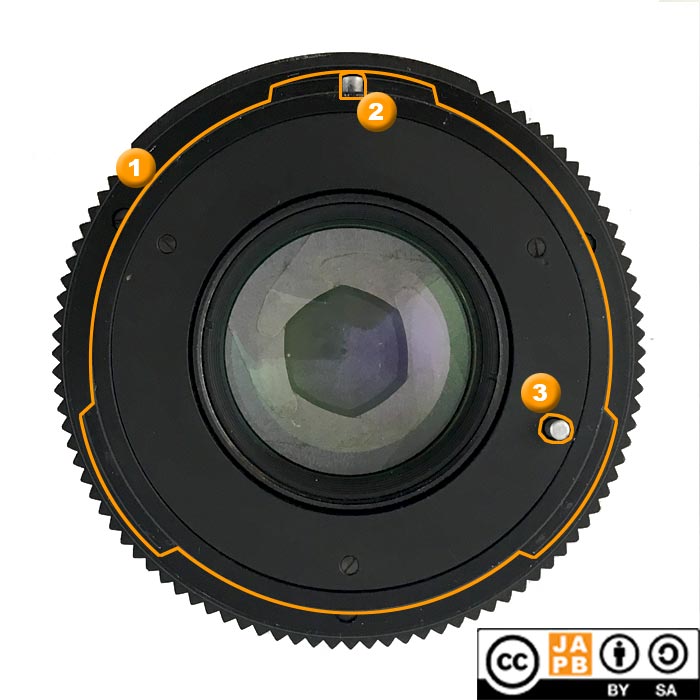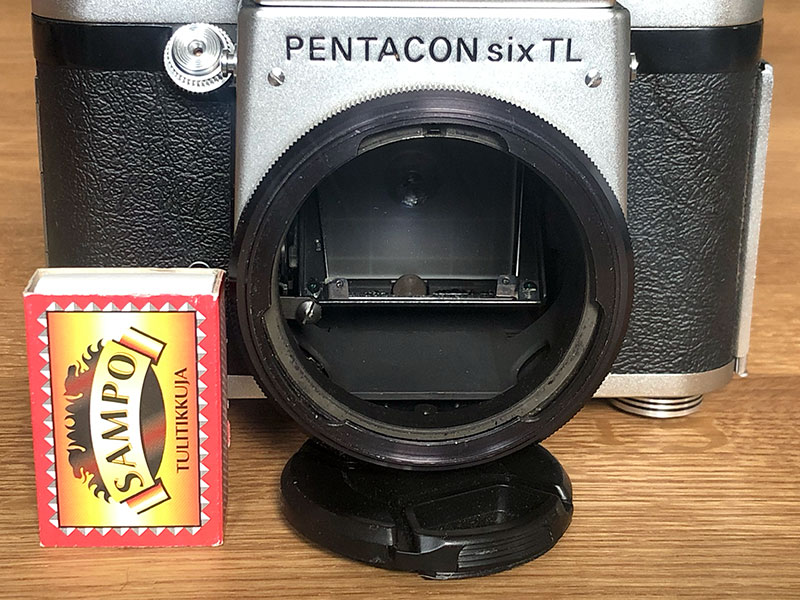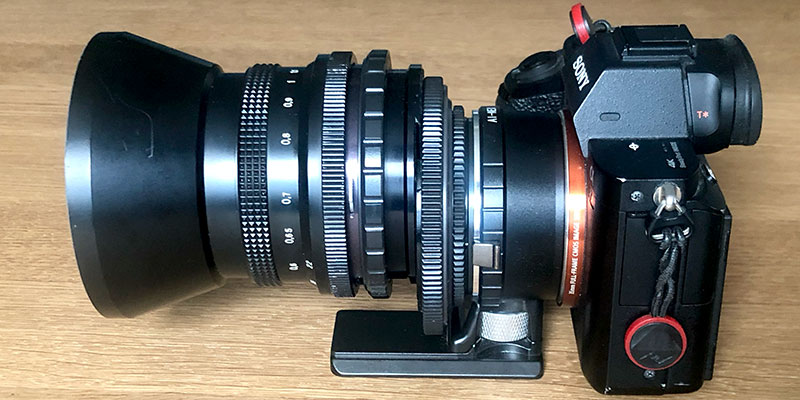Pekka Buttler (Updated 5/2025)
First off, and to avoid any subsequent confusion: the Pentacon Six mount is medium format SLR mount. If you know the implications of the larger format, skip this intro. Otherwise: read on.
Pentacon Six mount specifications and identification
Mount type: Breech-lock (ring on body)
Flange focal distance: 74,1 mm
Film format: 6cm x 6cm (‘Medium Format’)
Mount communication: one pin to direct the lens to stop down the aperture for the shot (camera-to-lens)

Identifying marks:
[1] Three lugs on mount (symmetrical)
[2] Orientation pin at 12:00 (on a camera, this always goes up)
[3] Aperture stop-down pin
Basic Information on the Pentacon Six mount:
That the Pentacon Six Mount is a medium format mount has two major implications:
1) Pentacon Six (alike other medium format lenses) are designed to produce a much larger image circle, in order to cover the much greater frame size of 120-format film – 56×56 mm in the case of the Pentacon Six. In general, this also means that medium format interchangeable lenses tend to be bigger than their ‘full frame’ or 135-format counterparts.
2) As the frame is larger, so too is the mirror, and unavoidably, so too is the mirror box. This leads to that the Pentacon Six’s flange focal distance is a very generous 74,1 mm. This has significance for adapting such lenses.

Pentacon Six – origins
The Pentacon Six mount (also called the Praktisix or P6 mount) was introduced together with the KW Praktisix camera (introduced 1957). The Praktisix is a medium format camera that in many ways looks like a regular SLR (horizontal film transport, mirror box in the middle, finder on top), except bigger. Viewed from the top, the Praktisix looks like a letter T. In this, the Praktisix differed greatly from the ‘box’ shape used in TLR’s as well as from the ‘cube’ shape used by many other medium format SLR’s (like classic Hasselblad’s, Bronica’s and Mamiya’s). The other well-known representative of the T-shaped medium format SLR’s is the Pentax 67.

Side note: Incidentally, the Praktisix is very much the big brother of the Praktina range of 35 mm cameras (introduced in 1953, manufactured until 1960), also manufactured by KW. That the Praktisix and Praktina share a lot of DNA is most obvious in that both the Praktina and Praktisix (and Pentacon Six) have extremely similar breech-loch mounts. To say that the Pentacon Six mount is an outsized version of the Praktina mount is accurate.
The Original Praktisix went through a long list of iterations and a name change (Praktisix->Pentacon Six) and its manufacture was ended only in 1990 with the demise of East Germany. While not as famous as some other medium format SLR’s (such as the legendary Hasselblad), the Praktisix/Pentacon Six concept was moderately successful, and was copied both in the East (Kiev 6C, Kiev 60, Arax 60) and in the West (Exakta66). Especially the Eastern variants are still being manufactured1. As a result of its moderate fame, A relatively wide range of lenses were manufactured for the Pentacon Six mount, including East German optics (most prominently Carl Zeiss Jena, but also Meyer-Optik), Soviet/Russian/Ukrainian optics (e.g. MIR, Jupiter, Vega) and West German optics (Schneider).

Matchbox for size reference.
Considering that the mount has been in active use for more than 60 years, some minor incompatibilities between various cameras and lenses have unavoidably crept in (see list here), but – by and large – these incompatibilities are minor and have little to no effect for the user intending to adapt the lens to digital – SLR or mirrorless; APS-C, full frame, or digital medium format.
Adapting Pentacon Six lenses.
First off, with Pentacon Six lenses being medium format lenses, they produce an image circle that comfortably covers all regular (APS-C to digital medium format) sensor sizes. Moreover, users of adapted Pentacon Six lenses are likely to be blessed by an effect called the ‘crop factor advantage’ 2.
On the other hand, given that crop factor and the fact that no focal reducers for Pentacon Six lenses currently exist, people who adapt Pentacon Six lenses will have no lenses that are able to produce a wide-angle image. Moreover, due to the Pentacon Six’s massive 3 flange focal distance, even relatively small Pentacon Six lenses will look big on dSLR’s and huge on mirrorless cameras.
But, that large difference in flange focal distances, combined with the greater-than-modern image circle also opens up one very interesting usage scenario for those adapting Pentacon Six lenses, namely Tilt and Shift adapters.

Carl Zeiss Jena Flektogon 50 mm f/4 lens,
Pentacon Six to Nikon F shift adapter (with max upwards shift)
Nikon F to Sony FE adapter with detachable foot.
Sony ⍺7R2
Links:
• The number one resource on the Pentacon Six system (by TRA): pentaconsix.com
• Pentacon Six review at casual photophile
• Pentacon Six review by Mike Eckman
• Arax foto
Footnotes:
1 Arax was manufacturing and selling Arax 60 cameras right up until Russia’s 2022 invasion of the Ukraine. Hopefully manufacturing will be able to restart soon.
2 The ‘crop factor advantage’ refers to that when using a lens on a smaller film/sensor than originally intended, only the centre-portion of the image circle is used, thereby lessening vignetting and avoiding or ameliorating many off-centre aberrations (such as field curvature and astigmatism).
3 The Pentacon Six’s flange focal distance (74,1 mm) is big compared to dSLR’s FFD’s (44–46,5 mm) and massive compared to that of mirrorless interchangeable lens cameras (16–26,7 mm). On the other hand, among other 6×6 format SLR’s the Pentacon Six’s flange focal distance is not big at all (min: Rollei SLX: 74,00 mm; max Rollei SL66: 102,8 mm) .